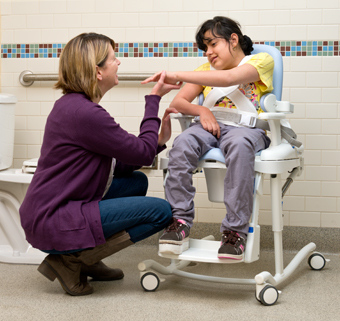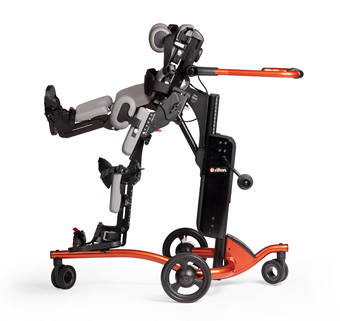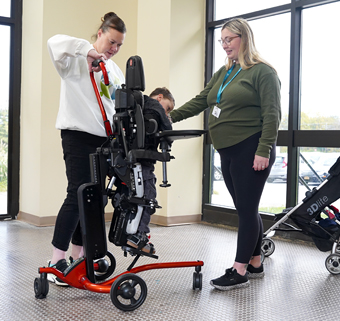Knowledge Is Power: Incorporating Evidence into Therapy Practice
| October 2024 Many questions can cross your mind over the course of a day as a therapist. How long should I recommend use of orthoses? Do I need to teach a child to crawl if they can scoot?
Many questions can cross your mind over the course of a day as a therapist. How long should I recommend use of orthoses? Do I need to teach a child to crawl if they can scoot?
As therapists we are taught to use evidence to guide practice, yet it can be harder than it sounds. The scope of questions to be answered and techniques to be implemented is vast and we have limited time to review literature.1-3 Some therapists are unable to access full text articles, lack collaboration opportunities, or have limited equipment and varying degrees of organizational support. Furthermore, evidence must be implemented in diverse settings.2,4,5 Something that worked in a research study may look very different from what can be accomplished in the “real-world”.
Despite these barriers, clinicians want to use evidence, and understanding evidence can improve patient outcomes.1,2,6-10 How can we increase the use of evidence? Key factors to success are (1) defining your question (2) matching the question to your knowledge translation approach (the systematic process of moving research findings into practical use), and (3) teaming up!11,12
Different knowledge translation questions require different approaches. There may be less published research available for certain unique diagnoses or interventions. In these cases, an individual clinician may be able to review, summarize, and implement the literature. However, when asking questions where the relevant literature is more extensive, looking for summaries or teaming up with other clinicians may be more appropriate. Let us review some real-life scenarios.
Examples of knowledge translation with adaptive equipment
A four-year-old child with spina bifida has plateaued in therapy. The family’s goal was to improve her walking ability with a walker. When reviewing the treadmill training literature for children with spina bifida, only three articles were available. In this case, the clinician was able to review, summarize and implement an evidence-based protocol to improve the child’s walking skills.13
Alternatively, when trying to improve the walking skills of a young child with a spinal cord injury using locomotor training, no pediatric research was available. In this case the clinician reached out to a researcher investigating locomotor training after spinal cord injury in adults using an email address found in a publication. This approach led to the development of a team including an adult locomotor training expert, pediatric PT researcher, and a treating clinician. Through this collaboration the clinician developed and implemented an evidence-based locomotor training protocol to improve the child’s walking skills.14
However, when trying to answer the impact of standing frames on children with cerebral palsy, the literature may be too extensive for one clinician to distill. In this case the clinician may look for summarized literature including systematic reviews,15-17 clinical practice guidelines, or fact sheets. Another approach might be to team up with peers to review the literature and develop context specific recommendations. This is the approach Nationwide Children’s Hospital took.18 A group of five therapists reviewed, summarized, and developed recommendations based on the literature specific to the hospital’s context. An algorithm was developed to guide clinicians to the ideal candidate, dosing, and methods to obtain a stander.
Knowledge translation resources
Using evidence to guide therapy is challenging; however, pairing questions with the appropriate knowledge translation approach and teaming up can make it achievable. See below for a list of resources to help you on your knowledge translation journey.
Accessing full text articles:
- PubMed: https://pubmed.ncbi.nlm.nih.gov/
- APTA article search: https://www.apta.org/patient-care/evidence-based-practice-resources/article-search
- Public library
- Google scholar: https://scholar.google.com/
- Pedro (Mossley2020): https://pedro.org.au/
Summarized evidence:
- APTA Pediatric Clinical Practice Guidelines: https://pediatricapta.org/clinical-practice-guidelines/
- American Academy of Cerebral Palsy and Developmental Medicine Care Pathways: https://www.aacpdm.org/publications/care-pathways
- APTA Pediatric Facts Sheets and Resources: https://pediatricapta.org/fact-sheets/
- CanChild: https://www.canchild.ca/
Need more knowledge translation experience?
- Consider signing up for a program through the APTA
If you have a question and don’t have a team, consider submitting a CPG proposal to the APTA.
Want to participate in a knowledge translation activity?
- Opportunities are listed when available on APTA Engage: https://www.apta.org/apta-and-you/volunteer-opportunities
References
- Cardin AD, Hudson MB. Evidence-Based Practice in the Hospital Setting: Views of Interdisciplinary Therapy Practitioners. J Allied Health. 2018;47(2):81-89.
- da Silva TM, Costa Lda C, Garcia AN, Costa LO. What do physical therapists think about evidence-based practice? A systematic review. Man Ther. 2015;20(3):388-401.
- Stander J, Grimmer K, Brink Y. Time as a barrier to evidence uptake-A qualitative exploration of the concept of time for clinical practice guideline uptake by physiotherapists. J Eval Clin Pract. 2021;27(2):280-290.
- Funabashi M, Warren S, Kawchok G. Knowledge exchange and knowledge translation in physical therapy and manual therapy fields: barriers, facilitators and issues. Physical Therapy Reviews. 2012;17(4):227-233.
- Nilsen P, Bernhardsson S. Towards evidence-based physiotherapy - research challenges and needs. J Physiother. 2013;59(3):143-144.
- Bartlett DJ. Advancing the Evidence Base of Pediatric Physical Therapy: "Sincerely, From the Heart". Pediatr Phys Ther. 2020;32(3):172-179.
- Graham F, Robertson L, Anderson J. New Zealand occupational therapists' views on evidence-based practice: a replicated survey of attitudes, confidence and behaviours. Aust Occup Ther J. 2013;60(2):120-128.
- Heiwe S, Kajermo KN, Tyni-Lenne R, et al. Evidence-based practice: attitudes, knowledge and behaviour among allied health care professionals. Int J Qual Health Care. 2011;23(2):198-209.
- Jette DU, Bacon K, Batty C, et al. Evidence-based practice: beliefs, attitudes, knowledge, and behaviors of physical therapists. Phys Ther. 2003;83(9):786-805.
- Thomas A, Law M. Research utilization and evidence-based practice in occupational therapy: a scoping study. Am J Occup Ther. 2013;67(4):e55-65.
- Condon C, McGrane N, Mockler D, Stokes E. Ability of physiotherapists to undertake evidence-based practice steps: a scoping review. Physiotherapy. 2016;102(1):10-19.
- Kamper SJ. Asking a Question: Linking Evidence With Practice. J Orthop Sports Phys Ther. 2018;48(7):596-597.
- Christensen C, Lowes LP. Treadmill training for a child with spina bifida without functional ambulation. Pediatr Phys Ther. 2014;26(2):265-273.
- Heathcock JC, Christensen C, Bush K, Butler M, Buehner JJ, Basso DM. Treadmill training after surgical removal of a spinal tumor in infancy. Phys Ther. 2014;94(8):1176-1185.
- McLean LJ, Paleg GS, Livingstone RW. Supported-standing interventions for children and young adults with non-ambulant cerebral palsy: A scoping review. Dev Med Child Neurol. 2023;65(6):754-772.
- Paleg GS, Smith BA, Glickman LB. Systematic review and evidence-based clinical recommendations for dosing of pediatric supported standing programs. Pediatr Phys Ther. 2013;25(3):232-247.
- Novak I, Morgan C, Fahey M, et al. State of the Evidence Traffic Lights 2019: Systematic Review of Interventions for Preventing and Treating Children with Cerebral Palsy. Curr Neurol Neurosci Rep. 2020;20(2):3.
- Christensen C, Wessells D, Byars M, et al. The impact of a unique knowledge translation programme implemented in a large multisite paediatric hospital. J Eval Clin Pract. 2017;23(2):344-353.







